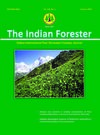A Rare Insectivorous Plant of Nanda Devi National Park: Pinguicula alpina L.
DOI:
https://doi.org/10.36808/if/2018/v144i1/121314Abstract
No Abstract.References
Ellison M. and Adamec L. (2011). Ecophysiological traits of terrestrial and aquatic carnivorous plants: Are the costs and benefits the same? Oikos, 120(11):1721-1731.
Givnish T.J., Burkhardt E.L., Happel R.E. and Weintraub J.W. (1984). Carnivory in the bromeliad Brocchinia reducta, with a cost/benefit model for the general restriction of carnivorous plants to sunny, moist, nutrient-poor habitats. Am. Nat., 124(4):479-497.
Givnish T.J.(2015). New evidence on the origin of carnivorous plants. Proc. Nat. Aca. Sci., USA. doi: 10.1073/pnas.1422278112
https://en.wikipedia.org/wiki/Pinguicula_alpina_distribution.svg
Juniper B.E., Robias R.J. and Joel D.M. (1989). The Carnivorous Plants. McGraw-Hill; New York.
Legendre L. (2000). The genus Pinguicula L. (Lentibulariaceae): an overview, Acta Bot. Gallica., 147(1): 77-95.
Patrat E. (1998). Pinguicula alpina, Trip report.
Downloads
Downloads
Published
How to Cite
Issue
Section
License
Unless otherwise stated, copyright or similar rights in all materials presented on the site, including graphical images, are owned by Indian Forester.





